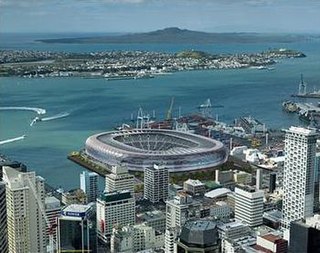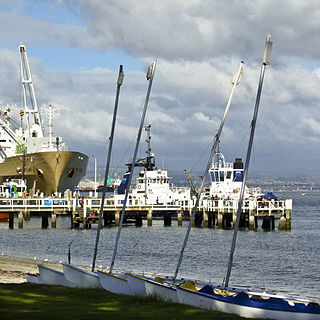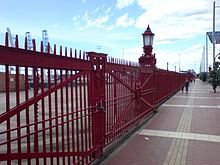
The Manukau Harbour is the second largest natural harbour in New Zealand by area. It is located to the southwest of the Auckland isthmus, and opens out into the Tasman Sea.

Waitematā Harbour is the main access by sea to Auckland, New Zealand. The harbour forms the northern and eastern coasts of the Auckland isthmus and is crossed by the Auckland Harbour Bridge. It is matched on the southern side of the city by the shallower waters of the Manukau Harbour.

The Rangitoto Channel is an area of the Hauraki Gulf in the Auckland Region of New Zealand's North Island. The channel is north-east of the Waitematā Harbour, and is located between the North Shore and Rangitoto Island. The channel's traditional Ngāi Tai name is Te Awanui o Peretū, and is an important deep water shipping channel to reach the Ports of Auckland.

Viaduct Harbour, formerly known as Viaduct Basin, is a former commercial harbour on the Auckland waterfront that has been turned into a development of mostly upscale apartments, office space and restaurants. It is located on the site of a formerly run-down area of the Freemans Bay / Auckland CBD waterfront in Auckland, New Zealand. As a centre of activity of the 2000 America's Cup hosted by the Royal New Zealand Yacht Squadron, as well as the 2022 Rally New Zealand, the precinct enjoyed considerable popularity with locals and foreign visitors.

Mechanics Bay is a reclaimed bay on the Waitematā Harbour in Auckland, New Zealand. It is also the name of the area of the former bay that is now mainly occupied by commercial and port facilities. Sometimes the bay formed between Tāmaki Drive and the western reclamation edge of Fergusson Container Terminal is also referred to as Mechanics Bay.

The Onehunga Branch railway line is a section of the Onehunga Line in Auckland, New Zealand. It was constructed by the Auckland Provincial Government and opened from Penrose to Onehunga on 24 December 1873, and extended to Onehunga Wharf on 28 November 1878. It is 3.6 kilometres (2.2 mi) in length and is single-track only.
Transport in Auckland, New Zealand's largest city, is defined by factors that include the shape of the Auckland isthmus, the suburban character of much of the urban area, a history of focusing investment on roading projects rather than public transport, and high car-ownership rates.

Stadium New Zealand, often called the Waterfront Stadium, was the provisional name for a national stadium proposed for the Auckland waterfront to host the 2011 Rugby World Cup. The stadium never advanced beyond a concept design.

Princes Wharf is a former commercial wharf on the Auckland waterfront, in Auckland, New Zealand, which has been redeveloped into a multi-story high-class mixed-use development and cruise ship terminal.

The Wynyard Quarter is a reclaimed piece of land on the Waitematā Harbour at the western edge of the Auckland waterfront, New Zealand.

The Auckland waterfront is a city-side stretch of the southern Waitematā Harbour coastline in Auckland, New Zealand. Previously mostly dominated by Ports of Auckland uses, from the 2000s on it is becoming increasingly open to recreational public use, with a number of former wharves being converted to office, entertainment, and later also some residential uses.

The Port of Tauranga is situated in Tauranga, New Zealand. It is the largest port in the country both in terms of total cargo volume, and in terms of container throughput with container volumes exceeding 1.2 million TEUs. The port is operated by Port of Tauranga Ltd. This article is about both the company and the port itself.

The Auckland Ferry Terminal, also called the Downtown Ferry Terminal, is the hub of the Auckland ferry network, which connects the Auckland CBD with suburbs in North Shore, West Auckland, and South Auckland, and islands in the Hauraki Gulf. The terminal is on the Auckland waterfront, at the north end of Queen Street, across Quay Street from the Waitematā railway station, which is the hub for local buses and trains.

The reclamation of Wellington Harbour started in the 1850s, in order to increase the amount of usable land for the then new City of Wellington. Land plots in the early city were scarce, with little room for public buildings and parks, as well as inadequate dockside areas for shipping. Reclamation progressively advanced into the harbour throughout the 19th and 20th centuries, providing room for public, commercial and industrial areas for the city. Large reclamations were made in the 1960s and '70s to meet the demands of container shipping and new cargo handling methods.
Queens Wharf is a concrete wharf in Auckland, New Zealand, that continues off Queen Street. It opened in 1913, replacing the Queen Street Wharf, a succession of wooden wharves first built in 1852. Queens Wharf was owned and used by Ports of Auckland until 2010.

Wellington Harbour Board was the body which formerly managed the shipping and commercial affairs of the port of Wellington in New Zealand. It was constituted in 1880 and was disestablished in 1989.
Eke Panuku Development Auckland is one of four council-controlled organisations (CCOs) of Auckland Council in Auckland, New Zealand. Eke Panuku manages a NZD$2.3bn property portfolio of non-core Auckland Council assets.

Quay Street is the northernmost street in the Auckland CBD, New Zealand. The Auckland Ferry Terminal, which has ferries running to Devonport, Waiheke Island, and other places in Waitematā Harbour; the Hilton Auckland hotel; and Ports of Auckland are on the north side of the street. The Britomart Transport Centre, Queen Elizabeth Square and Grand Mercure Auckland hotel are on the south side.

CentrePort Wellington (CentrePort) provides land and sea infrastructure and manages port facilities in Wellington Harbour in New Zealand. The company is the successor to the Wellington Harbour Board, and was formed as one of the outcomes of the 1989 local government reforms. This article is about both the company and the port.

Wharves in Wellington Harbour have been essential to the operation of the Port of Wellington and to the development of the city and the lower half of the North Island of New Zealand.


























